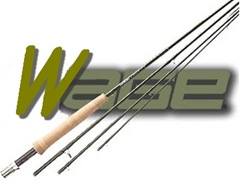 I managed to whip myself into a froth over the purchase of a new rod. It was a self inflicted wound so I have only myself to blame, TC didn’t help much with his scholarly work on the resurgence of fiberglass – I was feeling “retro” anyway’s, all he did was fan the flame.
I managed to whip myself into a froth over the purchase of a new rod. It was a self inflicted wound so I have only myself to blame, TC didn’t help much with his scholarly work on the resurgence of fiberglass – I was feeling “retro” anyway’s, all he did was fan the flame.
My second mistake was entertaining the idea seriously – serious enough to take a look at what was available, and then glancing down at the $#%@& price tag… Sweet Jesus…
If I was to dump $700 on something, I would be wiping it daily with the sleeve of a clean shirt, I would yell at a dog that got near it, and I’d consider striking a small child if they got milk-breath in proximity.
So much for graphite.
Those fiberglass rods sounded sweet, so I looked up the vendors TC mentioned and gazed fondly at their product, then glanced downward at the &%#@! price tag … Sweet Mother of God…
The only “fiber” in my “glass” will be Metamucil.
I built all my own rods as a young lad – money was tight and blanks were cheap, it added to the whole “roll your own” mystique; you tied your own flies, built the rod, and knotted together a leader; it was a rite of passage, and proof of your dedication. Thirty years later with a steady job and I’m still in the same boat – what’s wrong here?
The “elitism” thing has never been apparent in fly fishermen I meet – there are a few notable exceptions, but in large part the fly fishing community is friendly, hellishly opinionated, frequently misguided, insufferable in a social setting, but rarely snooty or elitist.
Is the root cause the vendor community and the usurious prices they charge for our tackle – leaving the common fellow to gasp in shock and damning us all as “rich guys” and pricks?
Tackle has me gasping – who in hell decided I needed Titanium in order to fish?
Bamboo rods required skilled artisans that spent decades learning the intricacies of cane and tapers, the advent of the Industrial Revolution shoved all them geezers to the side, and spat rods for everyone – mass production, reducing the man hours per rod and yielding a lower price point.
That’s still true today. Metal mandrels are wrapped with carbon film, heat shrink tape applied, and the result baked to completion. It’s the “McRod” – some fellow hits the “Crap Rods” button on a roomful of machinery and some other fellow catches them as they’re expelled from some mechanical bowel, they’re sanded, dipped, dried, and hung in a “clean” room.
It’s still a fast taper in Harm’s Way, meant to precede us through the brush, tossed into a pickup, and leaned against a pine tree while in camp. I can see my way to do that with $200, but not with a rig costing nearly $1300 with reel attached.
That violinist understands after parking his arse on a million dollar violin, … at least he had the good sense not to carry around a Stradivarius.
I’ve never heard a carpenter lust after the $600 hammers they sell to the Pentagon, so why is it we lust after this stuff?
 If it’s ostentatious we’re looking for – I’m going the Chihuahua route; a hairless rat-dog clutched tightly to my vest as I scour the fast water, a good trainer coupled with my ability to throw a tight spiral and it’s a hell of a fishing tool.
If it’s ostentatious we’re looking for – I’m going the Chihuahua route; a hairless rat-dog clutched tightly to my vest as I scour the fast water, a good trainer coupled with my ability to throw a tight spiral and it’s a hell of a fishing tool.
Madison Avenue is full of sharp fellows that know physics and chemistry were our weakness in school, so they plague us with terms like “NTiQ” – nano-titanium quartz. We oblige them by not looking it up to learn that nano-titanium powder, is among other things, a disinfectant, and you can call a fellow to quartz your garage floor with the same resin.
…but in a new flyrod … it’s the penultimate awesomenality* and you gotta have it.
The angling press deserts us when we need them most – to give an impartial review of new tackle, instead they obligingly regurge the copy provided with the “free” rod, and are convinced it’s cool because they got one..
… has gone out of their way to apply an exotic material, a fine layer to Quartz, that adds durability to withstand saltwater conditions, and adds the incredible power needed to play tug-a-war with the mammoth fish that reside in the ocean.
The Quartz adds power to the rod? … this from the guy that lit the Chem lab on fire?
I’m not old enough to mean it when I mention the “good old days” – but I know enough to prefer waving a 9 foot semiconductor in a lightning storm – to a full conductor compliments of Titanium.
Despite all the semi-scientific evidence cited, the final rub was knowing the Bush stimulus package will deliver a maximum of $600, enough to get a nice rod off of EBay, but it’s shy of contemporary gear. If we can restart the entire economy with that – imagine the industrial juggernaut we’d unleash if everyone bought a new rod.
You think maybe these damn things cost too much?
* Props to Buster Wants To Fish for the use of his prose.
Technorati Tags: fishing tackle, fly rods, expensive, Old Guy rant
 We ate all the big stuff, most of the medium sized stuff, and we’re working on the small stuff now. Next comes the really small stuff, those critters so important to the food chain that their absence upsets the entire apple cart.
We ate all the big stuff, most of the medium sized stuff, and we’re working on the small stuff now. Next comes the really small stuff, those critters so important to the food chain that their absence upsets the entire apple cart.
 That just ain’t fair,
That just ain’t fair,  You can enjoy your pristine wilderness-kinda experience, then wonder why your congressman boots you out of his office, despite amusing his secretary with fish costumes and chants about indiscriminate water bottle use.
You can enjoy your pristine wilderness-kinda experience, then wonder why your congressman boots you out of his office, despite amusing his secretary with fish costumes and chants about indiscriminate water bottle use. When examining another tier’s work I look at the head of the fly, it tells me everything I need to know about skill and degree of craftsmanship. The shape and size of the thread finish, the amount of debris trapped by the final knot are testimony to proper execution of proportion or whether he was crowded for space.
When examining another tier’s work I look at the head of the fly, it tells me everything I need to know about skill and degree of craftsmanship. The shape and size of the thread finish, the amount of debris trapped by the final knot are testimony to proper execution of proportion or whether he was crowded for space. Head cement is thinned to water consistency, materials trapped in the finish knot will wick head cement into the eye closing it completely. It’s a personal peeve of mine – 15 minutes of light left, fish slurping all around – eyesight failing – and your last #16 Elk Hair Caddis is a glue lump, nothing makes me swear louder.
Head cement is thinned to water consistency, materials trapped in the finish knot will wick head cement into the eye closing it completely. It’s a personal peeve of mine – 15 minutes of light left, fish slurping all around – eyesight failing – and your last #16 Elk Hair Caddis is a glue lump, nothing makes me swear louder. I’d just finished another hallway conversation wherein I defended myself, the rest of you louts, and our beloved pastime. I was fumbling for the file to notch my “gunbutt” with another eco-radical kill, when I was brought up short…
I’d just finished another hallway conversation wherein I defended myself, the rest of you louts, and our beloved pastime. I was fumbling for the file to notch my “gunbutt” with another eco-radical kill, when I was brought up short… I managed to whip myself into a froth over the purchase of a new rod. It was a self inflicted wound so I have only myself to blame,
I managed to whip myself into a froth over the purchase of a new rod. It was a self inflicted wound so I have only myself to blame,  If it’s ostentatious we’re looking for – I’m going the Chihuahua route; a hairless rat-dog clutched tightly to my vest as I scour the fast water, a good trainer coupled with my ability to throw a tight spiral and it’s a hell of a fishing tool.
If it’s ostentatious we’re looking for – I’m going the Chihuahua route; a hairless rat-dog clutched tightly to my vest as I scour the fast water, a good trainer coupled with my ability to throw a tight spiral and it’s a hell of a fishing tool. Like it or no it’s an election year and the current regime feels obligated to safeguard the economy until December, so’s they can blame whatever party takes power shortly thereafter.
Like it or no it’s an election year and the current regime feels obligated to safeguard the economy until December, so’s they can blame whatever party takes power shortly thereafter. I got my question answered and
I got my question answered and  It’s officially an election year, and we’re about to be courted by all the candidates and their
It’s officially an election year, and we’re about to be courted by all the candidates and their  I’m thinking the federal deficit would still be an issue, especially if they stock the Executive washroom with
I’m thinking the federal deficit would still be an issue, especially if they stock the Executive washroom with  I’m mortal, guilt got the better of me and I spent the better part of the weekend baking for neighbors and well wishers. Certain occasions require even the staunchest fisherman to succumb, I figured additional “brownie points” could be banked for later.
I’m mortal, guilt got the better of me and I spent the better part of the weekend baking for neighbors and well wishers. Certain occasions require even the staunchest fisherman to succumb, I figured additional “brownie points” could be banked for later.